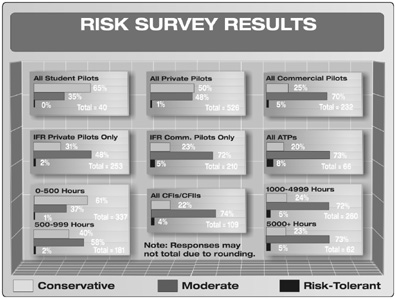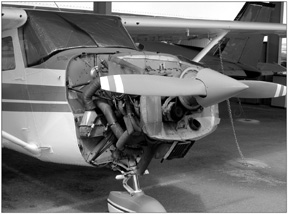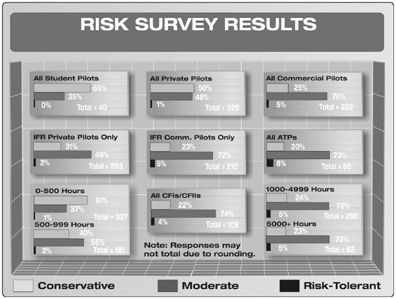
by Paul Bertorelli
Forty years ago, struggling to attach a definition to the slippery concept of obscenity, Justice Potter Stewart famously demurred. But he coined a catchphrase thats with us still: I know it when I see it. Although the justice was referring to racy magazines sent through the mail, he could just as well have been talking about our torturous attempts to pin down another vaporous concept: defining risk. Like Stewart, most of us know it when we see it but everyone sees it differently.
In an attempt to lend some hard numbers to the fuzzy notion of whats risky and whats not when flying airplanes, we asked Aviation Safety readers to take part in an extensive risk survey/quiz appearing in the December 2004 issue of the magazine with a link to our Web site. As explained in the January issue, the survey consists of 30 questions in six topic areas ranging from weather, to regulation to aircraft performance. Each of three responses is assigned a risk assessment: conservative, moderate or high risk. In the short space of three weeks, nearly 900 readers answered the survey, giving us a unique glimpse into how pilots think about risk and what challenges they consider too hazardous to undertake.
As promised, weve tabulated the results and herewith is a summary of our research. We dont have the space to summarize all the responses but these can be found on the Aviation Safety Web site at www.aviationsafetymagazine.com/surveys/RiskAssessment-Discussion.html.
We cant say we embarked upon this project with pre-conceived expectations and while we find the overall scoring averages to be interesting, we were more curious about how pilots would respond to the individual scenarios we constructed. What, for example, do they think about icing risk or how do they respond to mechanical squawks?
Where Do You Fit?
Our ranking of questions and the final scoring was subjective, of course, based on our standards and a degree of arbitrariness in the scoring system is unavoidable. Heres how the scoring worked: We assigned an escalating point-value to each question. The most conservative answer earned one point, a moderate answer two points and a highest risk answer three points. For cumulative totals, 60 or under total points ranked as conservative, 61 to 81 points as moderate and anything above that we considered to be risk tolerant.
One reader asked how we distinguished between a conservative decision and an aggressive decision. For example, he didnt agree that intentionally operating without a landing light at night was an aggressive risk choice.In our view, its only aggressive when compared to a more conservative decision to cancel a flight based on the inoperative light. Key throughout these considerations is the notion of comparative decision making. No flight decision can exist in a vacuum; the risk equation is a constant measuring of A against B or C against A.
For the survey takers as a whole-the vast majority of whom were Aviation Safety subscribers-42.4 percent ranked as conservative, 54.9 percent were moderately risk tolerant and the rest-a scant 2.6 percent-qualified as highly risk tolerant. This distribution is more or less what we expected to see, although we would have guessed the audience to be somewhat more heavily weighted toward conservative judgments. Maybe the questions werent hard enough.
IFR: A Field Leveler
Despite what pilots might think, the insurance industry believes that you arent a real pilot unless youre Instrument rated. But does having an Instrument rating make a pilot more or less risk tolerant? Our survey suggests the obvious: as a group, IFR pilots were more risk tolerant than those with only Private pilot ratings with no Instrument ticket and the point spread is not trivial. Among Instrument pilots, 66 percent scored as moderate risk takers while 48 percent of Private pilots without Instrument ratings ranked in the moderate group.
No surprise that the large majority of student pilots-65 percent-ranked as conservative, 35 percent as moderate and none as high risk takers. (We should hope not.)
Does experience-or, more accurately, an advanced rating-make a pilot more conservative or more willing to take risks? Our survey suggests the latter and thats not surprising. A higher percentage of both Commercial and ATPs scored as risk-tolerant than for the group at large. Some five percent of commercial-rated pilots and eight percent of ATPs selected the highest risk option among the three choices in the survey. Looked at another way, only 20 percent of the ATPs ranked as conservative decision makers.
Hours in the Seat
The old joke about there being old pilots and bold pilots but no old, bold pilots has some basis in fact. As pilots gain more experience, they gain confidence, but at some point, the survivors learn to recognize the onset of over-confidence. The classic case is the multi-thousand hour airline pilot who wont go near a piston single for night or IFR operations. (Not that we see anything wrong that, by the way.)
With respect to total pilot time, we sorted the survey responses into four groups: under 500 hours, between 500 and 1000 hours, 1000 to 5000 hours and more than 5000 hours.
The largest group in our survey was the under-500-hour crowd and the bulk of these pilots-61 percent-ranked as conservative with only 1.2 percent as high risk-takers. But bump the time up to the second group-between 500 and 1000 hours-and pilots are substantially bolder, with 40 percent calling themselves conservative, 57 percent ranking as moderately risk tolerant and 2.2 percent as highly risk tolerant.
Our survey didnt reveal much difference in attitudes between the 1000 to 5000 hours group and the graybeards with more than 5000 hours. The solid majority of both these groups-slightly more than 70 percent-selected the moderately risky choice in our flight scenarios while just under five percent opted for the high-risk solution.

What Scares Us? Or Not?
To us, the most interesting aspect of the survey is how it cast a light into the dark corners, where the inner demons live. We found sharp polarity in answers related to certain risk areas. As indicated in the graphics on the previous page, as a group, survey takers in general were more wary of some potential maintenance issues than of dicey weather, and, interestingly they seem to worry more about fine-point regulatory concerns than about encountering weather they cant handle. The survey suggests that readers view both icing and thunderstorm risks-or at least the way we posed these risks-about evenly.
Some scenarios stood out as being apparent yawners for readers. One posed flying home at night with a defective landing light. Forty percent of readers said no problem, theyd fly without the light at night while 51 percent said no, theyd cancel the flight until morning. As explained above, we consider flying the trip without the light to be comparatively the most risky, given the number of airplanes that run into things at night or run off taxiways even with a working light. Thats not to say its the wrong choice, but its not the least risky choice. And its very much one you may have to make.
Similarly, readers had no problem with the notion of flying an airplane with a failed EGT probe. Only seven percent said theyd delay the trip to fix it, the rest said theyd fix it after the next flight or as soon as practical. On the training front, we found some sharp divisions in what readers appear willing to do with a CFI in the right seat. One question asked about doing accelerated stalls in a non-aerobatic airplane. Forty-five percent said sure, theyd do it, while a nearly equal number-41 percent-said no thanks to this idea.
But when readers were asked to do practice ILSs in weather below minimums with a CFII, they were markedly less enthused. Only eight percent thought this was a good idea, 30 percent thought it was nuts and 62 percent said they would rather wait for better weather. Readers had a similar attitude toward the notion of stuffing an airplane onto a short runway for training purposes, again with a CFI aboard. Seven percent said yeah, lets go do it, while nearly 70 percent said, well, maybe, but I reserve the right to say no when I see the runway. Twenty-three percent said no thanks, theyd prefer a long runway for this training.
Mysteries Under the Cowl
Our survey suggests that readers are wary of flying airplanes coming out of maintenance and rightfully so. Heres the scenario we posed: your airplane has just come out of an annual during which a cylinder was replaced. The work got delayed and now you have to fly a night cross-country in good weather without a pre-trip test hop. Would you go or delay the trip?
Eight of 10 who answered that survey question said no way; 16 percent would go after de-cowling the airplane and closely inspecting it. Only four percent said theyd go, accepting the repair work at face value. When we dosed this scenario with some mild IMC, the numbers understandably shifted toward the conservative no-go decision, but not by much.
Readers were just as conservative when faced with the decision of flying a Cessna 172 with an iffy Bendix drive on the starter. Only five hardy souls-under one percent-said theyd consider flying the airplane as-is, propping it if necessary. Fully 82 percent would cancel the flight and put the airplane into the shop immediately. We conclude that hand propping an airplane holds little appeal for many and, frankly, we cant argue the point.
Survey participants appeared even less tolerant of oil leaks of unknown origin. One question postulated a preflight that revealed few drops of oil on the cowl flap of a turbocharged airplane. Some 97 percent of readers said they would either ground the airplane or have a mechanic inspect it before flight. Only three percent picked the option of flying the airplane after de-cowling and inspecting it for themselves.
What It All Means
As we explained in last months issue, there are no winners and losers in a survey such as ours and no right or wrong answers. Nor do we maintain that our overall findings are anything more than compelling answers to some challenging questions. The way you assess risk derives from a sum total of your fundamental attitudes shaped by your training and experience. If, for example, your CFII exposed you to an icing event during your training, you may be less nervous about encountering it on your own in the real world. If you learned to fly in a Piper Cub, propping an engine is old hat and the bum starter would be a nuisance, not a show stopper.
Some readers suggested that our survey questions were too narrow, too contrived or didnt offer enough real-world options. Further, some argued, our ideas of whats risky and whats conservative are all wet. Thats fair criticism, of course. However, we invoke the Potter Stewart doctrine; one mans risky is anothers walk in the park.

In our view, the value of a survey like this is to help you calibrate-or re-calibrate-your own judgments relative to those of others. Although theres not necessarily safety in numbers when it comes to risk assessment, the cause for pause comes at both extremes of the spectrum. If you consistently choose the high-risk answers across the board, you may wish to examine your judgments critically. Do you really understand the risks that keep others from making a similar judgment? What do they know that you dont? Do you have realistic alternative plans when the high-risk choices you tend to make dont work out?
If youre satisfied with your answers to these questions, so be it.Regardless of what others may think, theres nothing wrong with being comfortable with high-risk situations if you mitigate the risk reasonably and understand and accept the consequences.
We see a certain undesirability in residing at the opposite end of the spectrum, the over-conservative extreme, at least for pilots whove accumulated some experience. If you chronically find reasons not to fly due to perceived risk, you probably arent expanding or even maintaining your skill set. The more your confidence and skill erode, the more likely youll be unable to handle the inevitable odd novel situation when youre confronted by it, say a stiffer crosswind than you expected or worse-than-forecast weather. Just as for those pilots who are comfortable with high-risk decisions, theres nothing wrong with being too careful. But theres a price to pay for it, too.
Also With This Article
“Risk-Decision Snapshots”
-Paul Bertorelli is editor of Aviation Consumer and editorial director for Aviation Safety.




